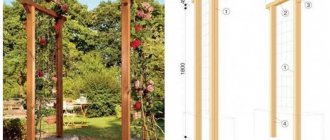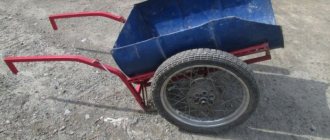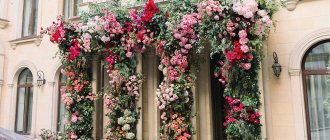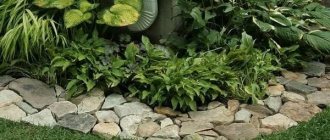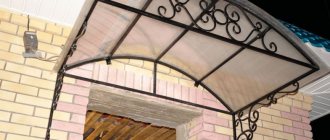Why arch
An arch is a unique structure consisting of two supports with an overlap. It appeared about two thousand years ago. Such a structure has found its home in garden plots. There are reasons for this, because arches can be used in the following variations:
- A decoration for any place wherever it is placed.
- The basis for climbing plants.
- An element that shows the boundaries of the landscape.
- Support for hanging a lantern.
- Frame for a hammock, swing.
- Part of the gazebo, fence.
Many more ideas can be put forward on how to apply this design. Arches in landscape design are a common option that help create unique compositions in a space. Thanks to them, the area becomes much more attractive.
Varieties
Arches differ from each other primarily in the shape of the vault. When we hear the word “arch,” we usually think of an arched ceiling. It is also made:
- straightforward;
- in the form of an angle (resembles the roof of a house);
- trapezoidal.
Arch in the form of a corner Source yandex.kz
Sometimes the entire structure is given a round or abstract shape. It can be single or look like several repeating identical fragments. A variant of such parts combined into one is called a pergola. They represent entire spans. If plants are already conveniently located on them, pergolas become excellent sun protectors.
Materials used
Another distinctive element of garden arches is the material used. It could be:
Metal
Often used due to its durability. Also attractive is its durability. Such arches perfectly withstand loads and resist winds. For greater stability, the lower part is inserted deep into the soil.
There are openwork forged arches that look very attractive in appearance. However, all metal arches have a drawback associated with the properties of the metal. It corrodes and develops rust over time. Therefore, it is necessary to remove it, treat the surface with a special solution and paint. Another disadvantage of this type of arches is the high cost. The price varies from 5,000 to 36,000 rubles.
Metal arches are strong and stable Source bahcekorkuluk.com
Stone
Stones of natural or artificial origin and brick are used. Such arches are specific because they look monumental. Although this is a capital structure. Only a good specialist can lay it out.
The main thing is that the stone arch matches the style of the site Source fotokto.ru
See also: Catalog of companies that specialize in construction services for small architectural forms.
Plastic
This material produces a lightweight structure that does not require special attention. However, lightness turns into a disadvantage under the adverse influences of nature. If a strong wind rises, the arch may not withstand its pressure.
It will not withstand severe frost either, so it will have to be put indoors for the winter. But for the price this is the most affordable option. For example, the cost of garden arches made of plastic pipes 2 m high and 1 m wide is within 1000 rubles.
Arches made of plastic cannot withstand extreme frost Source ydachadacha.ru
Tree
This natural, eco-friendly material is in great demand. Wooden arches for the garden are made in different styles: from simple lattice options to complex patterns.
Mostly lumber is used for their manufacture, but there are also products made from twigs. By weaving, picturesque designs are obtained that are in harmony with nature. Although any type of wooden arches fits into the design and looks aesthetically attractive.
Compared to metal ones, they are cheaper - from 2,000 to 15,000 rubles. The cost may be higher if the design is complicated and large in size.
Along with many advantages, wood also has disadvantages. It will last less than metal. To maintain external beauty, periodic tinting or varnishing will be required. Also, garden arches made of wood are not always wind-resistant, but this depends on how they are installed.
A wooden arch needs to be periodically tinted or varnished Source novamett.ru
Arbosculpture
Arborsculpture is simply a mesmerizing sight. When, instead of ordinary trunks, you see intricate patterns in front of you, trunks tied in a knot or a “basket” of 5-6 trees, you think: “How the hell did they do that?” Until you see such miracles with your own eyes, you will not believe that this is possible.
Arbosculpture appeared not so long ago - at the beginning of the 20th century. Three people (2 in America and 1 in Germany) independently began to experiment with living trees, creating various patterns and figures from their trunks and branches. To do this, they used techniques such as stretching, grafting and splicing.
In America, the experimenters were Axel Erlandson and John Krubzak. The famous chair made from several fused trunks is exactly the masterpiece of John Krubzak. It is located in Ambras, Wisconsin. And some of Axel Erlandson's sculptures can be seen in Gilroy Park, California.
In Germany, the arbosculptor was Arthur Vihula. In 1926, he even published a book in which he described the technique of creating multi-story buildings, bridges, towers and other architectural objects from living trees. Perhaps at the same time, in the process of writing the book, the term “arbosculpture” (in Latin “arbor” - tree) was coined.
It is unknown whether the authors of this technique have followers. But the direction is very interesting and it could take its rightful place in modern landscape design.
Doesn't it look like topiary?
Some may say that some of the above methods for creating various figures from trees do not relate to topiary art in any way. Because the techniques for creating them are not aimed at forming a crown, which is what characterizes topiary art, but at giving a special shape to the trunk and branches.
Yes, it is difficult to combine these methods with one word “topiary”. Because each of them deserves to be not just a method, but a separate art and have its own name.
But let's remember the meaning of the word "topiar". In English, “topiary” is not only the art of topiary, but also fantasy or patterned figures for the landscape. Take, say, any arbosculpture. Why not a fantasy figure for the landscape?
Or in Latin, the words “topiarius” and “topiaria” refer to ornamental art, gardening. And all of the above can be classified as ornamental gardening: nivaki, trees on a trellis, green arches, and arbosculpture.
Features of arranging wooden arches
The construction of wooden structures is distinguished by the fact that the support pillars can be well strengthened. Thanks to this, the entire arch will gain good resistance to adverse weather conditions. The pillars must be dug into the ground; the recommended depth is at least 70 cm. If the arch is higher than 2 m, then it is advisable that 30% of the length of the pillar goes into the ground.
A layer of crushed stone is poured into the bottom of the holes prepared for the posts. Then the pillars are installed there, their verticality is controlled using a plumb line. The next step is to install the side supports. When this is done, the holes are completely filled with crushed stone and concrete is poured there. After it hardens, you can continue to install the remaining parts of the structure.
Even a strong wind is not afraid of such a wooden arch in the garden Source doc4home.com
European style haircuts
In Europe, roof-shaped and umbrella-shaped crown trimmings are common. Umbrella-shaped haircuts are well obtained from winged euonymus, field maple, Canadian serviceberry, and dwarf forms of pine.
A roof tree can be formed from linden, for example. To do this, the trunk is cleared of branches to a certain height (2-2.5 m). Then a horizontal frame is installed under the crown, and thanks to it, all subsequently growing branches take a horizontal position.
If you plant several tree giants nearby, and then form roofs from their crowns, you will get a spectacular living canopy, where the trunks will be pillars, and the crowns will be the roof of the canopy.
Accommodation options
There is unlimited scope for imagination here. The arch can be installed at the very entrance of the site, where it will simultaneously be part of the fence. If there is a path on the property, it can be located on it. But at the same time you need to take into account the width, which should not be less than that of the sidewalk itself.
The ideal option is to make a bench or swing under the arch. Typically, such structures are located in secluded corners of the garden. There you can have a great rest, enjoying the silence and privacy. Arches are often used as an element that serves as a base for plants. Climbing roses look especially chic on them. When they grow, they create a magnificent dome of fragrant flowers.
Clematis, honeysuckle, and Chinese lemongrass look no less beautiful. Grapes also feel great on arches. It’s nice to pass by when its ripe clusters hang. An arch is a multifunctional structure, so it can be made part of a veranda or balcony. Sometimes boxes intended for flowers are fixed on the sides. In addition to their decorative function, they give the structure additional stability.
The arch can be part of the fence Source za.pinterest.com
About materials
Substitutions of materials are quite possible.
In conclusion, a short overview of the possibility of using wood and materials imitating wood.
| Material | Appearance | Impact resistance | Price component |
| Tree | Wood is wood, texture and color need no introduction | With impregnation against mold and fungal infection, periodic “refreshing” with varnishes and stains in the house it will serve, if not forever, then for a very long time. True, wood tends to shrink and become cracked. | Depending on the type of wood: from pine to oak - from minimum to maximum |
| MDF | Full wood imitation | It is easy to clean and quite durable, does not require tinting or impregnation, but an attentive viewer can easily distinguish imitation wood from the original | More expensive than pine, but cheaper than elite wood species. Undesirable for outdoor structures |
| Laminated chipboard | Low fidelity texture simulation | The surface can be wiped clean. | A budget option in the full sense of the word. Not suitable for outdoor structures. |
